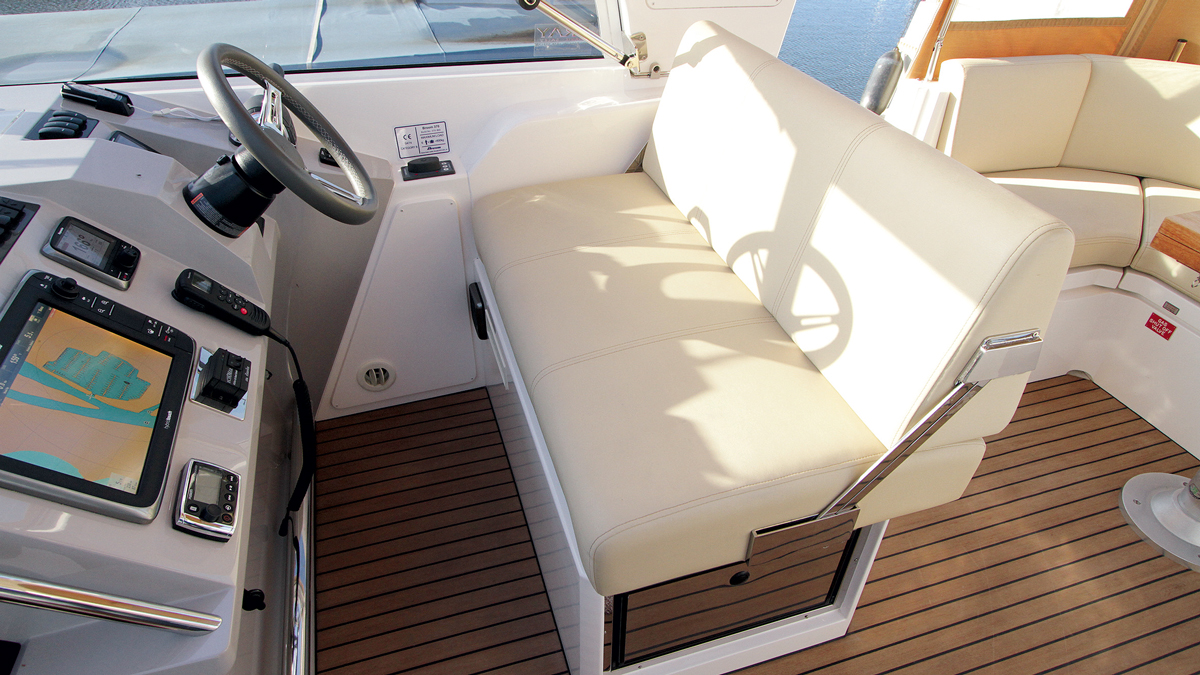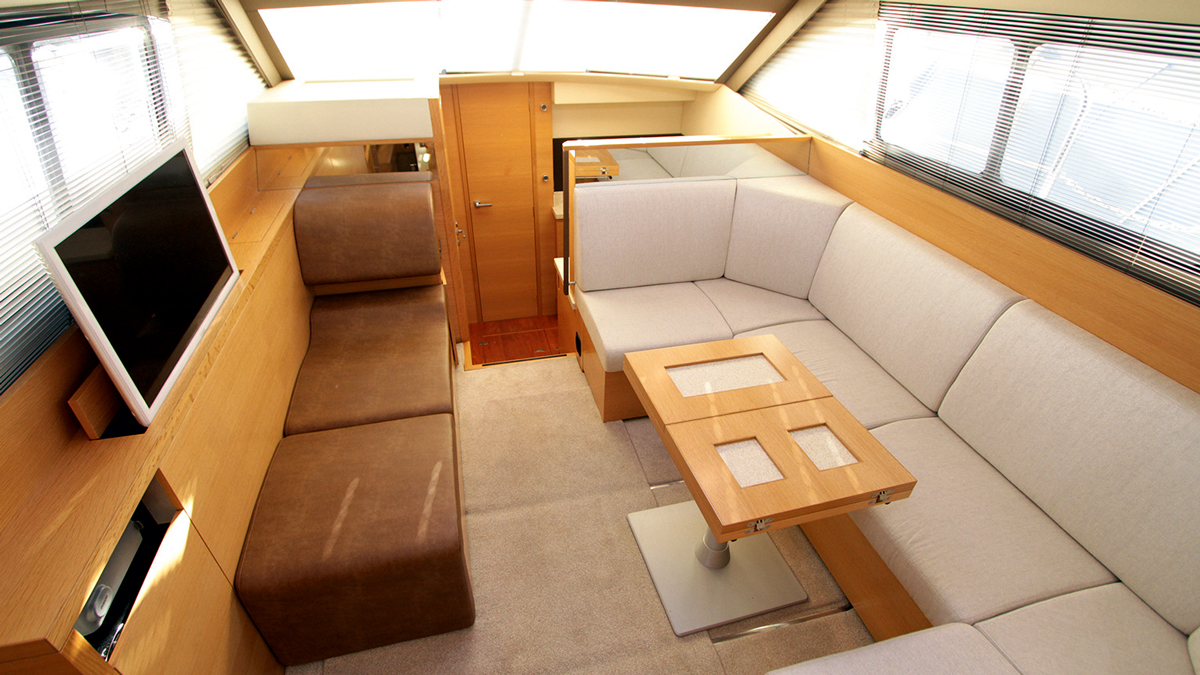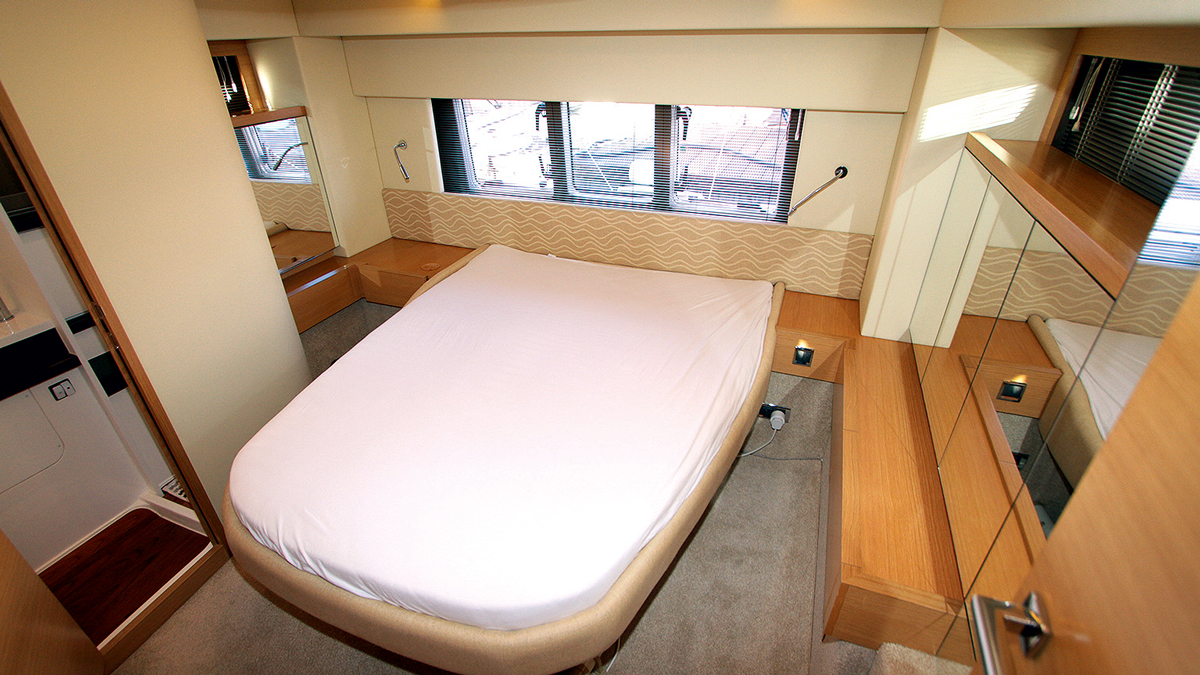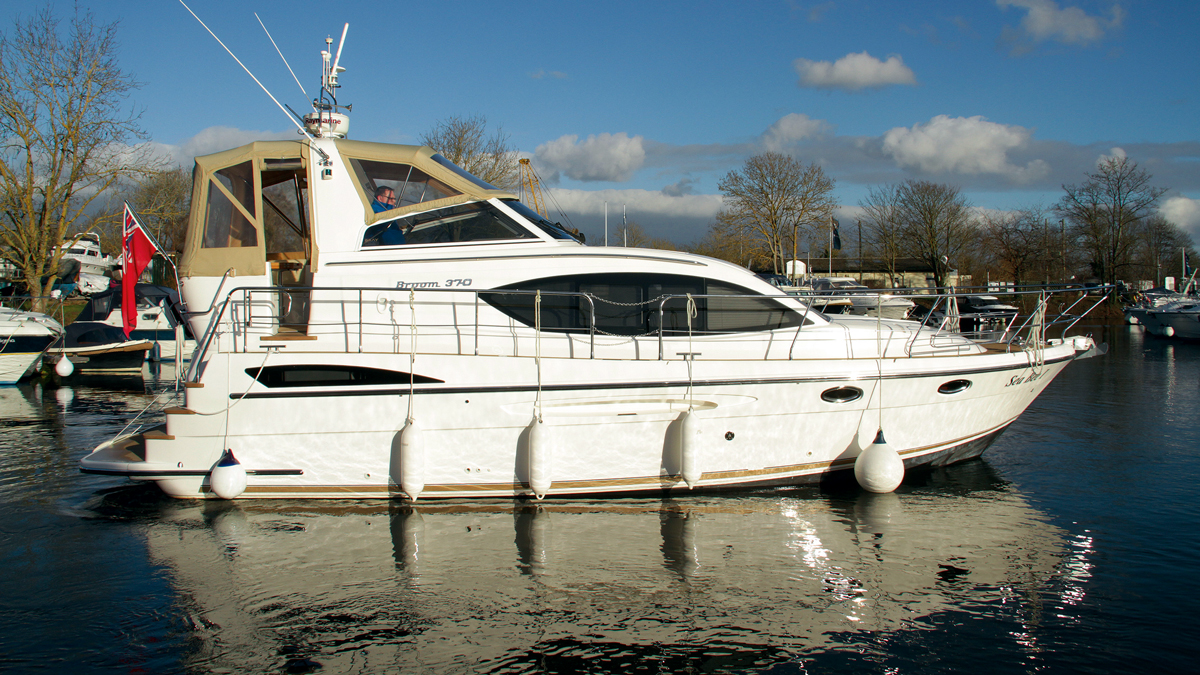Our resident used boat expert Phil Sampson explains how to spot a top quality Broom 370 on the secondhand market and what features to look for…
In-build: 2011-2018
Price range: £225,000–£280,000
When asked what attracted him to Broom in the first place, 370 owner Ian Callow replies, ‘Well, I’ve always understood that Broom boats are like the Rolls-Royce of British boating…’
And therein lies the enduring appeal of the brand; a quality UK product that transports its owners around in luxury and style.
Although Ian went on to caveat his statement by adding that some other makes are probably a bit more high end, there’s no question that Norfolk-based Broom Boats represented the best of British in terms of craftmanship and attention to detail.
Article continues below…

Broom 370
With a new designer and a new look, the 370 punches Broom into the 21st century
£304668

Princess 430 yacht tour: A surprising amount of boat for your money
Throughout its 120-year boat-building history – which began in 1898 and ran up until 2018 when the company shifted its focus to marine services and boating holidays – Broom Boats enacted the vision of founding father Charles John Broom to build “beautifully crafted sailing cruisers for gentlemen.”
As one of the last and largely hand-assembled models to roll off the line, the Broom 370, of which around 30 were built, demonstrates the firm remained faithful to its founder’s quality-build philosophy to the very end.
One thing Broom was not was a volume producer, so examples of the 370 are few and far between and tend to get snapped up soon after coming to market.
The boat we visited – Sea Bee 1 – was on sale with Bray Marine Sales with a price tag of £249,950. The broker expected it to be gone soon, a reflection of the esteem in which the brand is held.
Based on an Andrew Wolstenholme medium V-planing hull, the Broom 370 was an update of the former 365 hull and thus an example of what might be described as a modern-generation Broom.
While previous incarnations were conservative inside and out, the Broom 370 was smooth outside and sharp within, its flowing external lines complemented by a fresh new interior created by former Fairline design whizz, Graham Warren.
The result is a classy classic where relaxed styling rubs shoulders with a modern, attractive and practical interior. But for many owners, the 370’s real allure lies in its two distinct cabin areas, one up front and the other, a full-beam owner’s cabin, astern.
Both have their own bathrooms and are separated by the saloon, making them ideal for affording guests privacy or giving the kids their own space at the other end of the boat.
Few vessels in its class offer this arrangement, which at one time was popular in models such as the Trader 36 and Grand Banks 36 Classic.
River dwellers
According to Lee Gibbons of Bray Marine Sales, typical Broom 370 owners are likely to be those who spend more time aboard their boats than most, and use them more too: “The Brooms we see tend to have higher engine hours than other comparable boats,” he says.
This could be because many Brooms, including Sea Bee 1, live on rivers and hence spend many dreamy hours chugging slowly around at a stately six knots or so but that’s not always the case.
They are just as capable at sea as can be seen from the 2010 test carried out by MBY’s former stablemate Motor Boats Monthly of a Broom 370 equipped with twin Yanmar 6BY 260hp engines. This fared well in terms of its seakeeping in rough conditions and delivered 26 knots at a fuel burn of 106 litres per hour.
However, owners with the single engine D6 370hp option will do well to achieve the lower end of the 14-16 knot scale suggested by the manufacturer; owner Ian Callow noted a maximum speed of 13.5 knots when he brought his boat from the Thames around the coast back to his home base on the River Yare, and that vessel has a Coppercoated hull.
All 370s were shaft drive, with other engine options including twin D6s rated at 330hp and single Nanni configurations for river use of 170hp and 85hp. But there’s much more to a Broom 370 than just its performance, with comfort and safety aboard being high on the list.
Externally, the boat’s walkaround decks are a big plus point. These are accessed either directly from port and starboard side gates in the cockpit or from the large bathing platform by way of four steps, at the top of which are security gates.
Whichever way you go, grab rails are always close to hand, including all the way along the superstructure.
There’s no provision for sunpads on the foredeck but with the covers down, the Broom 370 offers plenty of sun-space in its spacious elevated aft deck.
Up here there’s a large curved seating area and the back of the substantial sliding helm seat, which we would describe as a generous two-seater, flips over to provide extra seating for socialising.
On the radar
The helm layout is clear and simple and includes a chart area protected by a hinged clear acrylic cover. There’s no wet bar up here but there is a small fridge under the helm seat. The cockpit has two more handy tricks up its sleeve.
One is its fold-away forward canopy; just release two side catches, pull on the handle above the windscreen, and up it goes to open up the helm.
The second is a collapsible radar arch, which allows it to sneak under low bridges. This again is quick to operate, but according to Ian Callow requires some strength unless the optional hydraulics are fitted. His boat didn’t have that, so he retrofitted gas struts to help.
Four steps lead down a companionway to the saloon, where deep pile carpet, a large three-sided settee and a chaise longue await together with plenty of storage. While the woodwork is all of superb quality, we did notice that the leaves on the extendable table drooped a little when open.
The same was true of the cockpit table, but that’s nothing replacement hinges, or a little packing, wouldn’t fix. The 370 has an extremely neat master power panel, which Broom must have been so proud of that they placed it on show on the saloon’s aft bulkhead.
The boat’s other circuit breakers are concealed behind a mirrored panel in the aft cabin. Opposite the sofa there’s a pop-up TV, and all-round Venetian blinds keep out the glare and provide privacy after dark – essential in a boat which features large areas of glass in the superstructure.
The saloon’s table is not bolted to the floor as it has to be moved in order to access the hatches which cover the engine(s).
The same goes for the chaise longue, which splits in two accordingly. This requires a certain amount of physical effort as the table is quite heavy and the chaise longue base is bulky. Once exposed, however, carrying out the daily checks is simple, with strainer(s), dipstick(s) and filters all readily accessible.
Forward of the saloon, two steps lead down to the galley. While this forms part of the open plan living area, the galley is more or less invisible from the saloon by virtue of its lower level.
From a cook’s perspective it is a joy, with substantial worktop space, hob, oven, microwave, fridge and plenty of storage (including under the floor) all tucked into a space where nobody can eyeball what you’re doing!
Another pleasing Broom touch is that they have thoughtfully included a hotplate stand into the worktop alongside the hob – not every boat builder does that.
Inside the Broom 370: Ample storage
Opposite the galley are the forward heads, complete with shower, which can serve as day heads or, as noted earlier, a dedicated washroom for the forward cabin. That cabin could be specified either as a V-berth or an offset double bed.
Our viewed boat had the V-berth, which leaves a convenient area for dressing between the beds. There is also ample storage, including wardrobes and there are long open lockers located on each side of the cabin.
At the other end of the boat the master aft cabin is large and spacious. The ensuite, which also has a shower, lies to starboard while the port side of the cabin is mirrored, adding to the impression of space.
There’s also bags of storage space in the integrated floor-to-ceiling cabinets at the foot of the bed, and we’d be tempted to look at adding a TV into this unit’s open centre section.
Criticism of the Broom 370 doesn’t come easily. Apart from the points we’ve noted above, our only other comment is that it has quite a few steps to contend with.
While this is not a problem per se, we did manage to trip twice going into the aft cabin, where at the foot of the stairs there is an awkward 45-degree half step leading into it. But in the scheme of things, that’s not such a big deal.
Every boat has its foibles, and we all learn to live in harmony with our pride and joy’s glitches – and in the view of those we spoke to, living in harmony is a good way to describe the experience enjoyed by Broom 370 owners.
Broom 370 surveyor’s report
Although often perceived as an inland waterways craft, a Category B RCD rating proves the Broom 370 is more than capable of being a comfortable offshore cruising vessel.
Clever design, with a raised aft helm position rather than a flybridge and a folding radar arch make her an adaptable craft to suit many cruising options.
Points to note when considering buying:
- Broom no longer make new boats which could affect re-sale values over time, although in the short term lack of stock may actually prop up values.
- These boats are often purchased as comfortable river homes, with limited opportunities for fast cruising, and as such are unlikely to have ever exceeded 7-8 knots. If purchasing with the aim of going to sea, it is essential to carry out a sustained sea trial prior to purchase to ensure all machinery and transmission is operating satisfactorily.
- Ensure that the correct anodes have been fitted for your intended cruising area. Salt or brackish water requires a different anode to fresh water.
- Canvas covers play a large part of the living enjoyment in these craft. Check
that all frames, mounts, hinges and pivot sections are sound, zippers run smoothly, fasteners are intact and plastics are clear and supple. - Sharp edges on most of the furniture and limited handholds between the companionway and the forward end of the saloon mean care must be exercised when moving around at sea.
- Osmosis issues should rarely show up on a vessel of this age. However, given the likelihood of these craft being berthed in fresh water, this can raise the possibility of osmotic blistering occurring prematurely, more so than in craft kept in salt water areas.
The combination of good build quality, machinery and components mean that a clean example should deliver comfortable, relaxed cruising for many years to come over a wide range of different destinations.
-Chris Olsen MIIMS
Olsen Marine Surveying
Broom 370 specifications
Type: Aft Cabin
Designer: Andrew Wolstenholme (Hull) / Graham Warren (Interior)
Hull type: Planing
RCD category: B
LOA: 37ft 7in / 11.46m
Beam: 12ft 4in / 3.78m
Draught: 3ft 4in / 1.02m
Air draught: 10ft 8in / 3.25m
Displacement: 8 tonnes
Fuel capacity: 1,000 litres (110 gallons)
Water capacity: 361 litres (87 gallons)
Top speed: 26 knots
Cruising range: 253nm
Annual fuel burn: 2,800 litres (50 hours cruising at 15.4 knots)
Annual marina mooring: £7,560 (on the Hamble River downstream of Bursledon bridge)
What’s on the market
Date: 2014
Engines: 370hp Volvo D6
Lying: Bray
Price: £249,950
Contact: Bray Marine Sales
First published in the May 2022 issue of MBY.
In association with SETAG Yachts. Design and refit specialists SETAG Yachts bring luxury to the pre-owned market – by creating the bespoke yacht of your dreams, with no compromise. To fall in love with your boat all over again visit www.setagyachts.com or call + 44 (0)1752 648618 for more details.
If you enjoyed this…
Be first to all the latest boats, gadgets, cruising ideas, buying advice and readers’ adventures with a subscription to Motor Boat & Yachting. Available in both print and digital formats, our monthly magazine will be sent directly to your home or device at a substantial discount to the usual cover price. See our latest offers and save at least 30% off the cover price.























